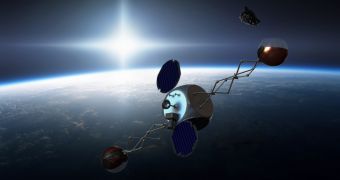Courtesy of advancements in the fields of science and technology, our good old planet is presently surrounded by myriads of bits and pieces of junk that are aimlessly flying around it and threatening future space missions.
More precisely, it is estimated that about 17,000 objects, each of which is at least as big as the average coffee cup, are currently circling Earth, the European Space Agency informs.
Under any other circumstances, these objects would not be all that big of a headache. However, studies have shown that, in space, even objects no bigger than 1 centimeter have the potential to cause irreparable damage to satellites.
This is because, high above our planet's surface, the force that stands to be released, should one such small object collide with a satellite, could turn out to be the equivalent of a hand grenade exploding here on Earth.
The good news is that researchers with the European Space Agency appear to have found a solution to this problem. Thus, word has it that the Agency is now looking into the possibility to use one very simple technology to retrieve space debris.
As detailed in a press release on the matter at hand, this very simple technology is the harpoon, which has been around since the Stone Age, when people first started using it to catch fish that they would later turn into their next meal.
On its website, the European Space Agency explains that it plans to use harpoons to catch fairly large pieces of space debris that constitute a threat to key orbits and that risk exploding and creating even more junk, should they overheat as a result of exposure to sunlight.
Information shared with the public says that, since it first got the idea to play Captain Ahab until present day, the European Space Agency has created a prototype harpoon and has even tested it with the help of brainiacs at the Airbus Defence and Space in Stevenage, UK.
The goal of these tests was to determine how the harpoon would behave when fired into satellite material, and whether or not this impact and the subsequent pull would birth any additional debris fragments that might compromise the mission.
By the looks of it, the Agency was quite pleased with the outcome of these experiments, hence its decision to move forward with this project and begin work on a system that would allow it to actually fire such harpoons in space.
It is estimated that, should things go according to plan, the first harpoons could be used to collect and remove space junk circling over our planet sometime in 2021.

 14 DAY TRIAL //
14 DAY TRIAL //